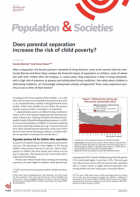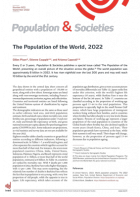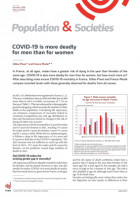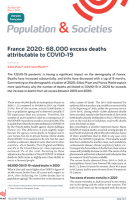
Is France still a demographic outlier in Europe?
Population and Societies
n° 620, March 2024
https://doi.org/10.3917/popsoc.620.0001
Institut national d’études démographiques (Ined)
Institut national d’études démographiques (Ined)
Muséum national d’histoire naturelle
Institut national d’études démographiques (Ined)
Fertility fell sharply in 2023 compared to 2022. Mortality decreased likewise, after three years of rapid increase, and net migration remained high. France was the European Union country with the highest fertility in 2022, and probably in 2023 also. Future trends remain uncertain, but high net migration should more than offset lower fertility if both remain at their 2023 levels. The French population should continue to increase up to 2070.
births, deaths, fertility, life expectancy, mortality, natural increase, net migration, population projections, France, Europe
Table of contents
- Appendix A References
1.
In France, the fertility decline that began in 2010 is still ongoing. What is the situation among its neighbours? The authors examine this downtrend in the European context of the last decade and use projections to examine whether the demographic developments of 2023 signal a possible future population decline.
On 1 January 2024, the population of France was 68.4 million, an increase of 0.3% over the previous year (Table 1, Figure 2). There were just 678,000 births in 2023, down from 726,000 in 2022, a decrease of 52,000 (–7%). The number of deaths also fell between 2022 and 2023 by almost as much as births, from 675,000 to 631,000 (–7%).(1)
This lower mortality is linked to the sharp increase in life expectancy at birth between 2022 and 2023, which reached 80.0 years for males and 85.7 years for females in 2023. With a gain of 0.7 years for males and 0.6 years for females, life expectancy overtook its 2019 level and resumed the long-term uptrend observed before the COVID-19 pandemic. This followed a fall in 2020, and a stagnation or only marginal increase in 2021 and 2022 due to the ongoing impact of the epidemic combined with several severe winter flu outbreaks and summer heatwaves.
While natural increase, a first component of population growth, is negative in most other European countries (21 out of 27) [1], it remained positive, although small (+47,000), in France in 2023, of the same order of magnitude as in 2022 (+51,000). The second component is net migration (difference between arrivals and departures from France). It was also positive, at +183,000 in 2023 according to INSEE estimates. It makes a much larger contribution to growth than natural increase (4/5ths in 2023).
As the number of women of reproductive age has fallen only slightly in recent years, the decrease in births is explained mainly by a decline in fertility [2]. After a small recovery in 2021 due to a recuperation of births whose conception was delayed by the first wave of the COVID-19 epidemic in 2020 (the most disruptive, with stricter lockdowns than the following waves), the total fertility rate resumed its downtrend. With an exceptional annual decrease from 1.79 children per woman in 2022 to 1.68 in 2023, it reached a historical low not seen since the end of the baby boom (excepting 1993 and 1994).
1.1. A fertility decline common to many other European countries
Despite the recent decline, France still had the highest total fertility rate in the European Union in 2022, and probably also in 2023 (Figure 1). The countries of northern Europe also had high fertility in the early 2010s, and all, excepting Denmark, have experienced an accelerating downtrend since the COVID-19 epidemic years. For some, such as Finland and Norway, the decrease was already clearly discernible from the 2010s. However, for the countries where recent data are available, a stabilization has been observed since 2022.
In the countries of southern Europe, where total fertility rates were already very low in 2014 (between 1.2 and 1.4 children per woman), fertility remained stable or fell slightly over the following ten years, except during the COVID-19 pandemic [3], with a dip that is clearly visible in the monthly data. Portugal is the only southern European country where an increase from 1.2 to 1.5 was observed over the decade.
The trends across the former Eastern-bloc countries are more diverse. Many saw a slight – but temporary – upturn in fertility, at either the beginning (Lithuania, Latvia) or the end of the 2010s (Hungary, Poland, Czech Republic). In most of these countries, fertility has now resumed its decline. In Hungary and Slovenia, the recent downturn is less marked, however.
1.2. Converging fertility levels in Europe, but an unequal ‘COVID-19 shock’
Fertility levels have converged over the last decade among France’s neighbours and the countries of central Europe. In Germany and Austria, where fertility was very low in 2014, the upturn has now ended, while in countries with fertility of between 1.8 and 2.0 at that time (Ireland, United Kingdom and France) there is a gradual downward trend, more pronounced than that of Belgium and the Netherlands, where the initial level was moderate (1.7).
Across Europe as a whole, fertility levels are less diverse than ten years ago, with an overall downward trend, as elsewhere in the world. The shock of the COVID-19 epidemic is visible practically everywhere, with a strongly negative impact on births in December 2020 and January 2021, corresponding to conceptions during the first wave. Not all countries were affected in the same way, however. Most countries experienced a temporary dip in fertility, often followed by a recuperation of births in the following months, as was the case in France (the rebound in Ireland, Belgium and the Czech Republic was actually larger than the initial downturn), followed by a resumption of the pre-COVID downward tendency. In northern Europe, Germany, Austria and the Netherlands, on the other hand, there was no downturn in early 2021, but rather a temporary increase in fertility before a return to the previous downtrend. The stable economies of these countries, and their generous family policies, sometimes including exceptional support payments during the COVID-19 epidemic, may have enabled couples to pursue their childbearing plans with confidence despite the general climate of uncertainty [3]. The sharp decrease in fertility from 2022, also visible in these countries, may be a signal of more deep-seated changes.
1.3. Is France facing population decline?
Does the decrease in births in 2023 herald a future population decline and more rapid population ageing? In November 2021, INSEE (the French National Institute of Statistics and Economic Studies) published population projections for France up to 2070, based on demographic trends observed in previous years [4]. Under the baseline scenario, fertility remains constant at 1.8 children per woman, a level close to that of 2020; mortality continues to decline at the same pace as during the 2010s, with life expectancy at birth reaching 87.5 years for males and 90.0 years for females in 2070; and annual net migration stays at +70,000 throughout the projection period. Under this baseline scenario, the population of France continues to increase to a peak of 69.3 million in 2044, then falls to 68.1 million in 2070 [5] (Figure 3).
1.4. But what if fertility is lower and net migration higher?
The changes observed since these projections were published do not entirely match the baseline scenario, while remaining within the bounds of the ‘high’ and ‘low’ scenarios. This is not surprising, as all projections are inevitably challenged and sometimes contradicted by reality. The aim is not to foresee the future but to determine how it would look under different sets of conditions.
We ran some new projections, with a ‘2023’ scenario which assumes that fertility remains stable at its 2023 level (1.68 children per woman rather than 1.8 as in the INSEE baseline scenario). It may continue to decline in coming years, stabilize as in some European countries, or move upward again. For example, fertility began falling in the 1980s and reached a low of 1.68 in 1993 and 1994, the same level as in 2023. It then increased steadily for around 15 years, until 2010. The assumption that fertility will remain at its current level thus represents a compromise between several possibilities. We assume that net migration remains stable at +180,000 per year, a level between the two final levels of 2020 and 2021 (+173,000) and the provisional figure for 2023,(2) rather than at +70,000 as in the 2021 baseline scenario. Our mortality assumption is based on an increase in life expectancy identical to that applied by INSEE.
1.5. If fertility stays at the 2023 level, natural increase will become negative from 2030…
Under the 2023 projection up to 2070, the decline in births and the increase in deaths results in a crossing of the two curves in 2030, the year when natural increase becomes negative (Figure A1 in the online appendix). From then on, the gap widens steadily, reaching –166,000 by around 2060. Compared to the 2021 baseline scenario, the number of deaths is slightly higher at the end of the projection as migrants (and hence their deaths) are more numerous. The number of births is slightly lower at the start of the period, but additional migrant births then make up for the deficit. All in all, natural increase remains relatively stable.
1.6. … but the population will increase steadily
Under the 2023 scenario, the population increases continuously to 72.1 million in 2070 (Figure 3). The total population is larger in 2070 than that of INSEE’s 2021 baseline scenario because net migration more than offsets the reduction in fertility. Population ageing is similar in both scenarios (see detailed projections and comparison inthe online appendix).
Of course, the future is not written in stone and trends may well diverge from those projected in the 2023 scenario. Fertility may continue to decline, net migration may rise or fall, and new mortality crises may occur. This projection nonetheless shows that if fertility and net migration remain stable after 2023 and life expectancy continues to rise, the population of France should not start falling before 2070.
Appendix A References
-
[1] Breton D., Belliot N., Barbieri M., Chaput J., d’Albis H. 2023. L’évolution démographique récente de la France. Les comportements des femmes et des hommes sont-ils si différents ? Population. https://www.ined.fr/fr/publications/editions/conjoncture-demographique/evolution-demographique-recente-de-la-france-2023/
-
[2] Papon S. 2024. Bilan démographique 2023. En 2023, la fécondité chute, l’espérance de vie se redresse. Insee première, 1978. https://www.insee.fr/fr/statistiques/7750004
-
[3] Sobotka T., Zeman K., Jasilioniene A., et al. 2023. Pandemic Roller-Coaster? Birth Trends in Higher-Income Countries During the COVID-19 Pandemic. Population and Development Review. https://doi.org/10.1111/padr.12544
-
[4] Algava É., Blanpain N. 2021. 68,1 millions d’habitants en 2070 : une population un peu plus nombreuse qu’en 2021, mais plus âgée. Insee première, 1881. https://www.insee.fr/fr/statistiques/5893969
-
[5] Toulemon L., Algava É., Blanpain N., Pison G. 2022. La population française devrait continuer de vieillir d’ici un demi-siècle. Population & Sociétés, 597. https://doi.org/10.3917/popsoc.597.0001
INSEE made an upward adjustment to numbers of deaths in 2023 (https://www.insee.fr/fr/statistiques/6959520). Based on the new provisional estimate of 638,266 deaths (a 5% decrease compared to 2022), births outnumbered deaths by 40,000 (natural increase).
This is an ‘apparent’ level of net migration obtained by comparing population change and natural increase. It is averaged over the last 3 years for which final data are available: https://www.insee.fr/fr/metadonnees/source/serie/s1169/documentation-methodologique
Cite the article
Anne Solaz, Laurent Toulemon, Gilles Pison, Is France still a demographic outlier in Europe?, 2024, Population and Societies, no. 620
 This document may be reproduced free of charge on paper or online using our Creative Commons licence.
This document may be reproduced free of charge on paper or online using our Creative Commons licence.

























